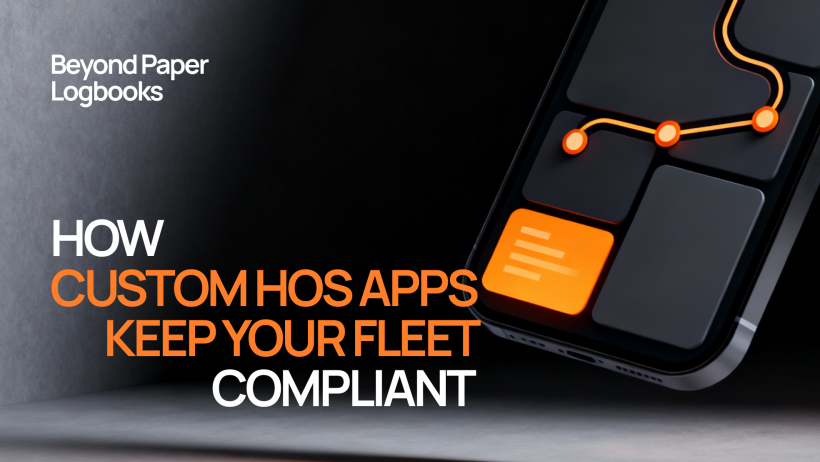According to Market Research, the time tracking software market will grow from $3.38 billion in 2024 to $18.17 billion by 2035, at a CAGR of 16.5%. Although this growth is largely driven by the transformation of businesses' approach to reorganizing their teams’ workflows caused by the COVID-19 pandemic, the lion's share of this market is still represented by driver-oriented solutions aimed at compliance with FMCSA hours of service rules. Actually, that’s what we’ll discuss below.
The Shift from Paper Logbooks to Electronic Logbook HOS Compliance
Previously, work time was recorded using paper logbooks. However, like any paper-based component, these are vulnerable to human error (an error in manual record can lead to HOS violations and fines). These logs also don't provide immediate access to data and complicate route audits and data interpretation.
This is how a digital logbook for truck drivers, or an ELD for short, emerged – it simply replaced outdated paper logbooks, thereby making work time recording fast and transparent. By the way, modern electronic driver logs software, in addition to recording work activity, can be integrated with GPS, fleet management systems, analytics platforms, and other third-party software and hardware to provide logistics managers with a unified flow of driver information.
It's also worth noting that transportation regulations are becoming increasingly stringent. For example, in the US, the FMCSA has mandated the use of ELDs for all commercial carriers, and similar mechanisms are gradually being implemented in Canada and Europe. Violations of these regulations can result in hefty fines and, in some cases, license suspension, so the fleet management electronic logbook deployment can be the most efficient option to prevent them.
Key Features of the Best HOS Tracking App for Truck Drivers

Regardless of the type of company, the best HOS tracking app should be enriched with the following features:
- Real-time Hours of Service (HOS) monitoring. These ELD compliance software features are aimed at ensuring real-time mobile hours of service tracking – that is, recording the start and end of a shift, time on the road, and, optionally, rest periods and downtime.
- Automated HOS violation alerts. Since transport companies are required to comply with driving time and mandatory break regulations, the app must be equipped with automatic alerts that help drivers monitor their schedules and adhere to established limits. Additionally, apps sometimes send duplicate messages to dispatchers to alert them of an impending violation and/or adjust the route or schedule.
- GPS-enabled trip logging and route optimization. Most HOS apps also include geolocation functionality for real-time analysis of routes, traffic jams, and stops, ultimately enabling them to independently model routes based on traffic conditions.
As for our practical experience, we implemented HOS functionality as part of the comprehensive SafeRouteAI solution. Specifically, we integrated it with Teltonika FMB920 trackers, added functionality for recording important events on the route (idle times, route deviations, speeding, etc.), and implemented AI-powered algorithms for identifying dangerous driver behavior on the road, including aggressive driving. As a result, the client was able to achieve full electronic logbook HOS compliance with local regulations regarding the work of their drivers. You can learn more about this case study here.
HOS Mobile App for Truck Drivers: Convenience on the Road
Due to its format, a mobile HOS compliance app for fleets is often designed specifically for road drivers. Development teams typically equip such software with offline functionality to avoid unstable operation in areas with poor or no internet connection.
Also, a custom-built HOS application features mobile-friendly dashboards that display all important information in one place (including remaining driving hours, rest schedules, current violations, etc.) and can sometimes be controlled by voice (since the driver's hands may be busy while interacting with the app).
Finally, another convenience of mobile ELD compliance solutions for carriers is their ability to be integrated with the rest of these carriers’ digital infrastructures, including dispatch, accounting, and payroll solutions. This ensures transparency and instant synchronization of all data and processes, while minimizing the impact of human error (such as incorrect manual data entry).
ELD Hours of Service Software for Fleet Compliance
The best electronic logging devices for fleets are connected directly to the vehicles’ engines and automatically record operating time, mileage, driving speed, and idle periods, thereby eliminating the need for manual data entry and associated errors. Furthermore, the data transmitted by ELD software to the central system is protected from editing (as it’s stored in an encrypted format), thus, reducing any unnecessary doubts from regulators about its authenticity. This means third-party audits become more accurate and objective.
Custom HOS Applications vs. Generic ELD Systems
Of course, you always have the option to buy an ELD hours of service solution by choosing a ready-made one. However, such HOS electronic logbook integration and customization capabilities are limited, so as a company's workflows become more complex and its personnel scale, it no longer meets their needs.
Custom alternatives, on the other hand, are built from the ground up around specific business processes and take into account specifics of routes (long-haul, regional, or last-mile delivery), fleets, work shifts, and corporate standards. Thus, although custom development requires a significant initial investment, its ROI quickly becomes increasingly clear, especially for companies that are constantly growing.

How Custom HOS Apps Improve Safety and Productivity
Custom mobile HOS tracking solutions help prevent driver fatigue, optimize their schedules, reduce the likelihood of accidents, and ensure predictability of fleet operations, all with minimal manual intervention. Ultimately, this leads to fewer HOS violations, thereby avoiding inspections and fines.
It's also worth noting that HOS apps generate a huge amount of data that can be used to improve fleet management efficiency – for example, for analytics on time on the road, routes, violations, and fuel consumption.
Future of HOS Compliance with Electronic Logging Devices

Electronic logging devices are gradually evolving from simple online monitoring solutions to highly intelligent systems capable of predicting risks and proactively managing driver behavior.
To address these challenges, in fleet management electronic logs, developers typically use artificial intelligence, which processes colossal data arrays in real time, identifying potential violations before they occur and suggesting schedule adjustments.
Another trend is the integration of HOS systems with cloud-based fleet management platforms. This ensures data is accessible at all times to all employees involved in the transportation process, from managers and logistics specialists to drivers and technicians. Cloud-based HOS compliance software makes data analysis faster and easier (which positively impacts workload management and trip planning) and also ensures scalability and secure data storage, even as fleets grow.
Finally, it's worth noting promising trends, such as interface personalization and integration with IoT devices – they provide software accessibility and, accordingly, simplify data collection.
FAQ
What is the difference between an electronic logbook and an ELD hours of service software?
An ELD hours of service software is a digital equivalent of a paper logbook, where the driver manually enters data on work and rest/idle time. Meanwhile, ELD software connects directly to the vehicle and collects data automatically, eliminating manual entry errors.
How do HOS mobile apps help drivers avoid violations during long hauls?
HOS mobile apps for truck drivers track driver hours in real time and provide automatic notifications to them before limits are reached, so dispatchers can plan stops in advance and, thus, avoid fines.
Can small fleets benefit from custom HOS tracking apps, or are they only for large carriers?
Custom ELD software for small fleets can benefit them by increasing workflow transparency, eliminating violations of FMCSA and similar regulations, and improving route planning and driver scheduling without the need to hire new employees.
What happens if a driver’s HOS app stops working during a trip?
The vast majority of driver logbook compliance apps are designed to work offline, but even if this option isn’t provided, after connecting to the network, all information entered into the system is automatically synchronized with the central storage.
How do electronic logging devices (ELDs) affect roadside inspections?
HOS regulations electronic logging devices speed up the process of roadside driver inspections because inspectors have instant access to digital reports without having to check paper documentation.
Are there specific HOS regulations for electronic logging devices that fleets must follow?
Yes, there are strict standards for ELD systems (like FMCSA hours of service regulations in the US) that define the data transmission format, how it’s stored, and how it’s protected from unauthorized editing.
What features define the best HOS tracking app for compliance and safety?
The best ELD app for independent truckers combines automatic driver and truck data capture, offline functionality, an intuitive driver interface (often with voice control), and real-time analytics for operators.

